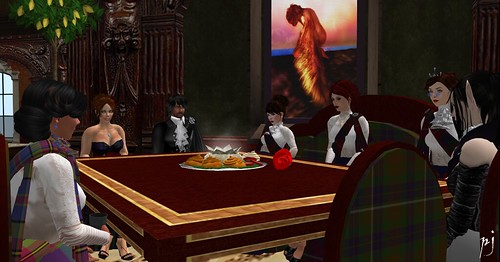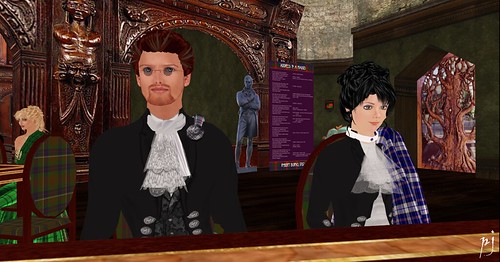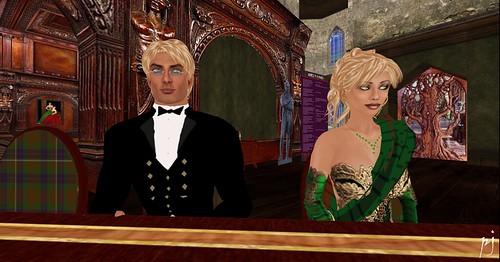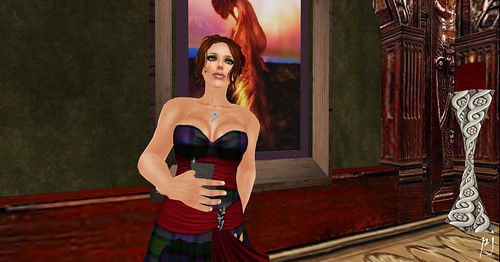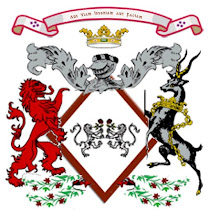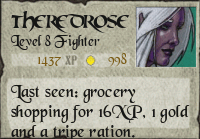Lord Cee Edman offered the Loyal Toast to Miss Serra Anansi.
At this point in the ceremony, I asked that all guests join me in the Immortal Memory of Mr. Robert Burns:
Seneschal, My Lords and My Ladies, Ladies and Gentlemen. Please join with me as I toast the memory of Scotland's National Poet and the person whose life and accomplishments we celebrate tonight.
Many thousands of Scots around the world celebrate Burns night on his birthday, January 25th. It is perhaps extraordinary that there is a Burns Supper at all. Why do Scots the world over participate in "Burns Supper" to perpetuate the memory of their National Poet? Why do not other groups gather annually to celebrate the memory of the famous writers of their nations? Why for example is there no Dickens Dinner, Tolstoy Tea, Shakespeare Roast, or Balzac Barbecue -- or some other such event?
It would be presumptuous to assert the answers to these questions. But, perhaps by reflecting on Robert Burns and his life we can discover some of our reasons for celebrating his memory tonight.
Had Robert Burns lived today, his earnings from one song alone -- Auld Lang Syne -- would have made him a multi-millionaire on a par with writers as Irving Berlin and George Gershwin and performers such as Elvis Presley and Paul McCartney. Yet, when he died in 1796, aged thirty-seven, he was poor and asking financial help of acquaintances. So what was it then about the life of this fellow, born into a poor farming family and departed in poverty that brings Scots together each year to celebrate his memory?
Perhaps he was a Scottish "Everyman." Perhaps his writing spoke to the basic emotions, thoughts, desires and fears of every person regardless of nation or rank. People frequently attribute certain traits to the Scottish character. Primary among them are a down-to-earthness, a plain-ness, a directness, a fierecely independent spirit, and a common touch. Perhaps these traits have more universal appeal than is often appreciated. It is not possible to do justice to Robert Burns character in the time allotted. Perhaps a few examples of his character, as seen in his poetry, will do.
Burns loved people despite their weaknesses, but hated hypocrisy.
One biographer stated that the Reformer, John Knox, had more in common with Burns than with the stereotype we have of Knox today. He stated that Burns and Knox were desperate men of crisis who played their parts in opposition to false or abused authority. Burns' biographer wrote that had Knox seen the abuses of the Church at the time of Burns, he would have allied himself with Burns against the established Church and many of its pillars of the community.
In the poem, Holy Willie's Prayer, Burns pointed his barbed wit at a self-righteous, member of the congregation as an example of the kind of hypocrisy that can poison any institution. Holy Willie, by his own complaints and by church standards, is shown to be an example of what to avoid. He enumerates his own misdeeds, mentioning some of them by their first names and frequency in the week.
Burns was opposed to anyone being treated in a servile manner.
Robert Burns addressed his hatred of slavery in a poem, The Slave's Lament:
"It was in sweet Senegal
That my foes did me enthral
For the lands of Virginia, 'ginia, O!
Torn from that lovely shore
And must never see it more
and alas! I am weary, weary, O!
"The burden I must bear,
While the cruel scourge I fear,
In the lands of Virginia, 'ginia, O!
With the bitter, bitter tear,
And alas! I am weary, weary, O!"
Burns loved Liberty.
Robert Burns wrote of himself: "The first two books I ever read in private, and which gave me more pleasure than any two books I ever read again, were The Life of Hannibal and the History of Sir William Wallace. Hannibal gave my young ideas such a turn that I used to strut in raptures up and down after the recruiting drum and bag-pipe, and wish myself tall enough that I might be a soldier; while the story of Wallace poured a Scottish prejudice in my veins which will boil along there Ôtill the floodgates of life shut in eternal rest."
Burns disliked superstition as a means by which people enslave themselves. However, he drew upon the rich lore of Scotland and its legends and fairly tales to produce symbolism in his poetry.
Burns loved learning.
A Burns biographer once wrote that it "was parish gossip that, if you called on William Burness at meal-time, you found the whole family with a book in one hand and a horn spoon in the other."
Burns inherited his parents love of learning, a yearning that helped him to keep an open mind about himself, his Maker, acquaintances, and his surroundings.
The traits that seem to mark Burns' character all point back to the inescapable fact that he was a Scot.
The stereotype of the Scotsman, thanks largely to Sir Walter Scott and Sir Harry Lauder, is a fellow wearing highland attire. In his life, Burns certainly did not fit that stereotype at all. From reading his poems we gain the picture of a lowland Scot who dressed "English" according to the style of a farmer. The book which contained most of Burns' poems, titled Poems, Chiefly in the Scottish Dialect, made a favorable impression on the literati of Edinburgh. I suppose we would call the literary critics of the time "Liberals" today. They found their theories about the sensitivity of the common man confirmed by what they called this "ploughman poet." Burns spent the winters of 1786-87 and 1787-88 in Edinburgh as a national celebrity, but he disliked the condescension with which he was treated and so returned to farming.
No, Burns did not fit the stereotype of the Highlander in his own life or in the image he projected to literary society. However, it is interesting to note that he penned at least one poem to sing of a displaced Scot:
"My heart's in the Highlands,
my heart is not here,
My heart's in the Highlands a-chasing the deer,
A-chasing the wild deer and following the roe
My heart's in the Highlands, wherever I go!
"Farewell to the Highlands, farewell to the North,
The birthplace of valour, the country of worth!
Wherever I wander, wherever I rove,
The hills of the Highlands forever I love."
We now toast Robert Burns! Lover of people, lover of freedom and liberty, lover of truth, lover of learning, a lowland farmer, a Highlander at heart, a Scot.
To Robert Burns!
Lady Rowan Derryth responded (quite energetically) with a toast to the lads.
As always, following the toasts, readings of Mr. Burns' works were provided. Lady Gabrielle, Lady Rowan, Miss Homewood, and several others shared their favorite pieces with us. Truly is was a joyful night as we listened to our friends recite and toast utilizing either voice or text (or both) in celebration of the Bard.
Lady Gabrielle ended the formal portion of the evening by reading the Grace After Supper.
Even George came out to dance.
I will complete this post by simply saying that by the end of the night, my feet were bare, my hair completely loose, and my heart happy. Thank you again for allowing me to celebrate this joyous night with you.








